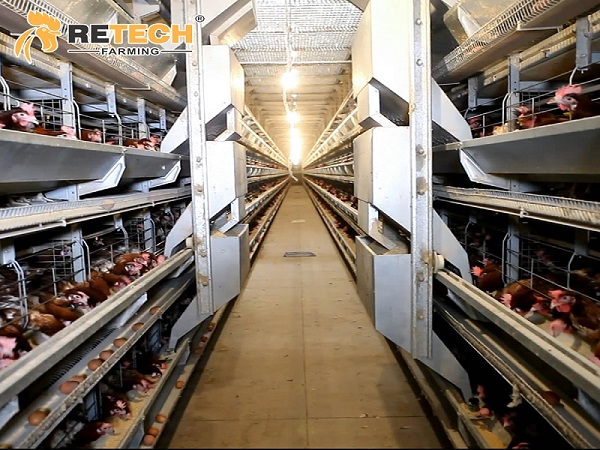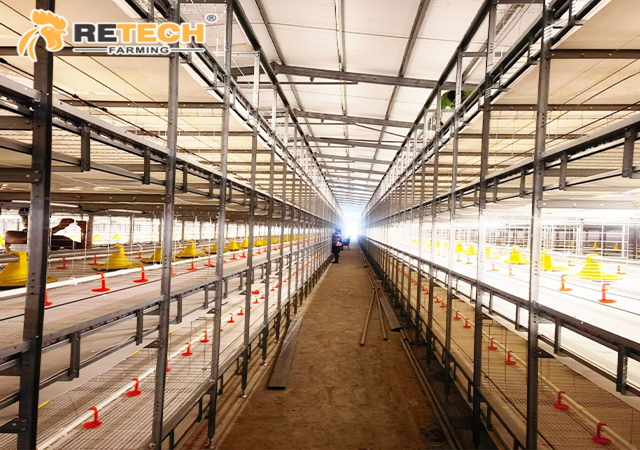1.What is a battery cage chicken?
2.What is the purpose of a battery cage? Why choose to use chicken battery cages (what are the advantages of poultry battery cages?)
3.What are the disadvantages of a battery chicken cage?(What are the disadvantages of a battery cage system in poultry?)
4.What is the difference between a deep litter and a battery cage?
5.Battery chicken cage project in the Philippines
6.Retech Farming: Poultry Solutions in the Philippines
7.FAQ
1.What is a chicken battery cage?
Chicken battery cage is a closed breeding system for laying hens. It consists of a series of interconnected cages, each unit cage several chickens. The cages are usually made of wire, which is easy to clean and manage. Battery cage system is a common way of large-scale layer farming.
In the Philippines, more and more farmers are upgrading from ground farming to poultry cage system. Types of cage system Broiler cage, laying hen cage.
2.What is the purpose of a battery cage? Why choose to use chicken battery cages (what are the advantages of poultry battery cages?)
The main purpose of a battery cage is to increase egg production efficiency. By keeping hens in a manageable environment, managers can more effectively monitor their health, feed, and egg-laying patterns. The system can:
♦ Increase egg production: Battery cages help increase egg production due to the controlled environment and reduced stress on the birds.
♦ Space efficiency: By stacking the cages, farmers can utilize vertical space and improve land utilization.
♦ Easy to manage: Automated egg collection, feeding, watering and environmental control systems reduce labor costs.
3.What are the disadvantages of a battery chicken cage?(What are the disadvantages of a battery cage system in poultry?)
♦ Limited space and movement: The limited space for chickens to move around in caged environments is not conducive to stretching their wings or engaging in natural behaviors such as dust bathing and foraging.
♦ Animal welfare issues: Confining hens in small cages raises ethical issues related to animal welfare. The limited space restricts the hens' natural behaviors such as nesting, foraging and social interaction.
♦ Hygiene hazards: Accumulation of feces can easily breed bacteria (such as Salmonella), increasing food safety risks.
♦ Risk of disease transmission: If not managed properly, chicken cage battery systems may increase the risk of disease transmission among chickens.
4.What is the difference between a deep litter and a battery cage?
4.1 What is Deep Litter chicken farming?
By laying 5-10 cm thick litter (such as sawdust, rice husks, straw, etc.) on the floor of the chicken house, the chickens can move and excrete on the litter, and the feces can be decomposed into organic matter, which can allow the chickens to move more naturally. It can also effectively reduce breeding costs.
The key difference between the thick litter system and the layer cage system is the chicken house environment and the freedom of the hens.
Chicken Battery Cage System VS Deep Litter System
| Feature | Battery Cage | Deep Litter |
| Space | Cages in the chicken house, limited space | Space on the ground or above the ground, more room for movement |
| Management | High degree of automation, easy to manage, reduced labor requirements | More labor management required, such as cleaning litter |
| Egg Collection | Automated egg collection system | Requires more labor |
| Hygiene | Easy to clean and manage, less risk of disease transmission (if managed properly) | More susceptible to disease transmission |
| Animal welfare | Limited space, may affect animal welfare | Hens can move freely, animal welfare is relatively high |
| Productivity | Higher, but requires careful management | Lower, but depends on management and environment |
| Applicable scenarios | Large-scale industrial production | Small farms or organic farming |
| Initial cost | High initial equipment investment (metal cages and automation systems required) | Lower (no complex equipment required) |
5.Battery chicken cage project in the Philippines
We have established cooperative customers in the Philippines. The equipment has been operating normally, improving the breeding efficiency for customers and gaining their trust. The following is an introduction to some projects:
Layer Cage Project
Breeding scale: 20k laying hens
Equipment name: A type layer cage
Equipment model: A4160
Broiler Cage Project
Breeding scale: 80k broilers
Equipment name: chain-type broiler harvesting cage equipment
Equipment model:
6.Retech Farming: Poultry Solutions in the Philippines
We are committed to providing innovative and efficient farming solutions to meet the growing market demand in the Philippines. Retech farming is a leading poultry farming equipment manufacturer in China, providing automated layer cages, broiler cages, brooding equipment and steel structure buildings. Contact us now, we will provide solutions and quotes for your farming scale! Get the checklist you need to start your project now!
Specification list of H-type layer battery cages
| Model | Tiers | Door/set | Birds/door | Capacity/set | Size (L x W x H)mm | Area/bird(cm²) |
| RT-LCH3180 | 3 | 5 | 6 | 180 | 2250*600*430 | 450 |
| RT-LCH4240 | 4 | 5 | 6 | 240 | 2250*600*430 | 450 |
| RT-LCH5300 | 5 | 5 | 6 | 300 | 2250*600*430 | 450 |
| RT-LCH6360 | 6 | 5 | 6 | 360 | 2250*600*430 | 450 |
Specification list of A-type layer battery cages
| Model | Tiers | Door/set | Birds/door | Capacity/set | Size (L x W x H)mm | Area/bird(cm°) |
| RT-LCA3120 | 3 | 4 | 5 | 120 | 1800*495*430 | 446 |
| RT-LCA4160 | 4 | 4 | 5 | 160 | 1800*495*430 | 446 |
7.FAQ
1.What happens when a battery hen stops laying eggs?
If your caged hens stop laying eggs, there are several things that may be going on:
♦ Health issues: Hens may not lay eggs due to health issues, such as malnutrition, illness, or stress. You need to check the health of your chickens to make sure they are properly fed and cared for.
♦ Age factors: Hens usually peak in egg production around 18-50 weeks of age, after which egg production will gradually decline and eventually stop.
♦ Environmental stress: The caged environment may affect the egg production of hens, such as insufficient light, small space, and lack of exercise. Improving the environment may help restore egg production.
♦ Malnutrition: Lack of necessary nutrients, such as calcium, phosphorus, and vitamin D, can lead to a decrease in egg production or even cessation of egg production.
In short, there are many reasons why hens do not lay eggs, and they need to be analyzed and treated according to the specific situation.
2.What are the breeds of native chicken farming in the Philippines?
The main breeds of chickens raised locally in the Philippines include the following:
White Leghorn Hybrids for Eggs、Rhode Island Red、Hubbard/Arbor Acres Broilers、Cobb Broilers、Hubbard White Feathered Chicken、Hybrid Layer Breeds
3.What are the types of poultry farming in the Philippines?
There are mainly the following types of poultry farming in the Philippines:
♦ Backyard Poultry Farming:
Features: This is the most common poultry farming method, especially in rural areas. It is usually small-scale and does not raise many poultry (a few to dozens)
♦ Semi-Intensive Poultry Farming
Features: The scale is between backyard farming and intensive farming.
♦ Commercial Poultry Farming:
Features: It is large-scale, usually raising thousands or even tens of thousands of poultry.
♦ Contract Growing:
Features: Feed companies or processing companies provide chicks, feed and technical support, and farmers are responsible for breeding. Farmers sign contracts with large poultry companies and breed according to the company's standards and requirements.
♦ Organic Poultry Farming:
Features: Use organic feed, do not use antibiotics and hormones, provide a good breeding environment, and pay attention to animal welfare.
Post time: Jul-14-2025









